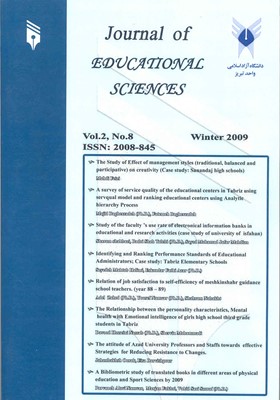The Study of Effect of management styles (traditional, balanced and participative) on creativity (Case study: Sanandaj high schools)
Subject Areas : Educational Psychology
1 - مدرس دانشگاه آزاد اسلامی واحد سنندج
Keywords: Creativity, education, management style,
Abstract :
This study investigated the relationship between management styles (traditional, moderative and participative) with creativity of public high school's teachers; the type of this research is survey-correlation. The statistical community includes all teachers of high schools in the Sanandaj city during 2006-2007. Using Stratified random sampling based on the formula of Cocran 275 people as sample were selected. Management Semantic differentiation Scale and creativity questionnaire were used for data collection. Validity and reliability of these instruments were obtained by Using Item analysis and Cronbach Alfa. After gathering and analysis of data, it was found that there is significant positive relationship between management styles and creativity which the more participatory behaviors the more relationship. The amount of Beta that is obtained between management dimensions (decision making, communication, leadership, structure and control) and creativity of teachers showes that Using of (monitoring of teachers by themselves, open mutual communication; friendly intimacy relationship and delegation of authority to teachers) increased the amount of creativity. In addition the results of study showes a significant difference between the two groups of male and female managers in their management styles, ie women have more participatory management style rather than men.
منابع
آقایی فیشانی، تیمور( 1377 ). "خلاقیت و نو آوری در انسانها و سازمانها". چاپ اول:
انتشارات ترمه.
اسلامی پور، حمیدرضا (1379)." بررسی نقش مدیریت مشارکتی در افزایش کارایی
کارکنان". پایان نامه کارشناسی ارشد. دانشگاه مرکز آموزش مدیریت
دولتی تهران.
اسمی، کرامت (1385). "بررسی تحلیلی رابطه ساختار سازمانی با خلاقیت سازمانی در
مدارس متوسطه شهر شیراز"، پایان نامه کارشناسی ارشد مدیریت آموزشی،
دانشگاه شیراز .
پورجلی، فریبا (1379). "بررسی تفاوت جنسیتی در تأثیر انگیزش بیرونی (پاداش)
برخلاقیت دانش آموزان"، پایان نامه کارشناسی ارشد، دانشگاه شیراز.
زاهدی، شمس السادات (1382)." ارتقای مشارکت زنان در سطوح مدیریتی ایران". فصلنامة
دانش مدیریت، شمارهی 62.
زکی، محمدعلی (1382)." بررسی نقش عوامل شخصیتی، سازمانی و اجتماعی در نوآوری
مدیران آموزشی". مجلهی رهیافت، شمارهی بیست و ششم.
کریمی، علی (1379 ). "رابطة خلاقیت با اضطراب، جنسیت، پیشرفت تحصیلی و
منزلت اجتماعی گروهی از دانش آموزان مقطع سوم راهنمایی شهر
شیراز". پایان نامة کارشناسی ارشد، دانشگاه شیراز.
مصطفوی، فرشته (1381 ). "بررسی میزان مشارکت اعضای هیات علمی دانشگاه شیراز
در تصمیم گیری های مدیریتی". پایان نامة کارشناسی ارشد، دانشگاه شیراز.
نوری، زهرا (1381 ). " بررسی تفاوتهای جنسیتی با توجه به رابطة خلاقیت و عملکرد
تحصیلی در دروس ریاضی، علوم و ادبیات دانش آموزان دبیرستان شهر
شیراز". پایان نامة کارشناسی ارشد، دانشگاه شیراز.
وفایی، سارا (1378)."بررسی رابطه بین سبکهای مدیریتی مدیران در مدارس شهر
سمنان با رضایت شغلی معلمان". پایان نامه کارشناسی ارشد، دانشگاه سمنان.
هاشمی، رویا (1383 ). "مدیریت مشارکتی از طریق نظام پیشنهادها". چاپ اول. شیراز:
انتشارات راهگشا.
Amabile, T.M,(1988). A Model of Creativity and Innovation in
Organization. Creativity Research Journal, 2:231-253
Bartel, p. (2006).participatory management methods to increase
staff input in organizational decisionmaking. www.scn.org
Kanungo, Rabindra N., and Jaeger, Alfred M.(1990): Introduction:
The Need for Indigenous Management in Developing
Countries, Management in Developing Countries, Alfred M.
Jaeger and Alfred N. Kanungo, eds., Chapman and Hall, Inc.,
New York.
Martins, E. C. and Terbalanche, F. (2003). Building organizational
culture that stimulates creativity and innovation, European
Journal of Innovation Management, Vol. 6 (1), 64-74.
Mavondo, Felix and Farrel, Mark (2003). Cultural orientation: its
relationship with market orientation, innovation and organizational
performance, Management Decision, Vol.41 (3), 241-249.
Ozsomer, Aysegul; Calantone, Roger J. & Benedetto, Anthony Di
(1997). What makes firms more innovative? A look at
organizational and environmental factors. Journal of Business
and Marketing, Vol. 12 (16), 400-416
Pierce, J.L. and Delbecq, A, L, (1997). Organisation structure,
individual attitudes and innovation, Academy of Management
Review, Vol.2, January, 22-37
Rice, G,(2006). Individual Values, Organizational Context, and
Self-Perceptions of employee creativity: Evidence from
Egyptian organizations.journal of Business Research, vol.25.
pg 233,241 pgs.
Solomon, G.T., Duffy, S., & Tarabishy, A. (2002). “The State of
Entrepreneurship Education in the United States: A Nationwide
Survey and Analysis.” International Journal of
Entrepreneurship Education, 1(1): 65-86.
Thacher,R.A,(1997). Team Leader Style: Enhancing The creativity of
Employees in Teams: Training for Quality, vol.5 No.4,
pp.146-9.
Woodman, Richard w,(1993). Toward A Theory of Organizational
Creati. The Academy of Management Review .vol.18,


